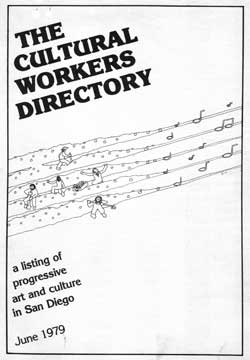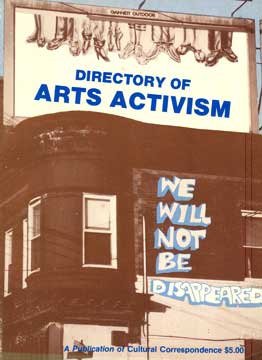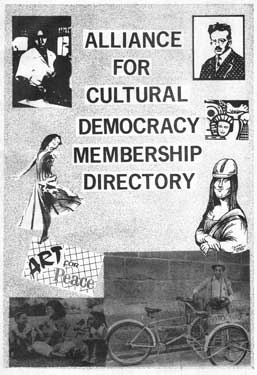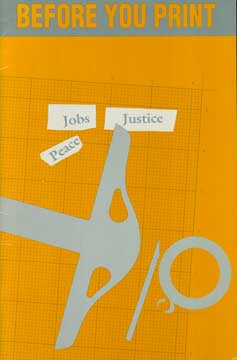Artist and
cultural worker directories
Organizing artists has been likened to the challenge of herding cats,
but that doesn't mean one can't try. These four publications, from 1979
to 1988, reflect community-building efforts to self-identify cultural
activists and help share their talents. Compared to the dazzling
fast-paced world of the Web and e-mail lists these may now seem quaint,
but at the time they were key organizing documents.
The
formats for these directories followed a similar style - a prefatory
statement about the importance of art and politics, followed by
listings with name, contact information, and offered skills and
interests. Poetry, photos, and illustrations made them snappy. I worked
on all of them, and are part of my research library. Sample pages of
these can be seen here.
Lincoln Cushing

The Cultural Workers
Directory, 1979
In the mid-1970s San Diego had a small but committed community of
cultural activists. This directory included 35 individuals and groups.
Inclusion in this directory was limited to those who agreed with the
following statement:
"Most art and culture in our society serves to reinforce its dominant values, such as elitism, racism, individualism, competition, and classism. A progressive cultural worker is one who recognizes that neutrality in art is a dangerous myth, and that by refusing to deal with the political context in which art exists places that person in the position of supporting the status quo. In response to this situation, she/he is committed to directing a substantial portion of her/his artistic work towards the elimination of exploitation and. oppression in people's lives. She/he recognizes that, far from compromising the arts, a combination of artistic expression and critical outlook can result in far more creative thought and expression than 'art for art's sake'. Thus, a progressive cultural worker is one who is community-based and actively engaged in working for political change at the same time that she/he strives toward higher artistic and political consciousness."

Cultural Correspondence magazine published this massive (160 page) directory, with listings broken down into five national regions and illustrated with media icons ("Dance," "Mail art," "Video") offering quick clues as to subject interests.

Alliance for Cultural Democracy Membership Directory, 1988
ACD was the major national progressive cultural workers organization during the 1980s. This directory was modeled after CC's earlier version (above), but was limited to listings from ACD members.

The San Francisco Bay Area had a long tradition of progessive graphic design and artwork, and this guide made it easy for community groups to find the resources they needed to make propaganda happen. The guide included an extensive introduction to the processes of graphic publication at the time (complete with now-ancient tasks such as typesetting and layout).